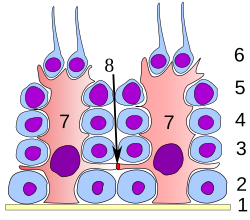Sertoli cells
Sertoli cells are pyramid-shaped cells with an elongated to triangular nucleus with a low volume of heterochromatin and a prominent nucleolus.
They arise from the surface epithelium of the gonads. It is located in the testicles, more precisely in the germinal epithelium of the seminiferous tubules. They attach to the basal membrane and their protrusions extend between the individual developmental stages of the sperm, often protruding into the lumen of the seminiferous tubule. They are connected to each other by tight junctions and nexus. Their main functions are nutrition and protection of spermatogenic elements (they are the only ones in contact with blood - the hematotesticular barrier), the ability of phagocytosis, the production of testicular fluid and anti-müllerian hormone.
Links[edit | edit source]
Related Articles[edit | edit source]
References[edit | edit source]
- VOKURKA, Martin – HUGO, Jan. The Great Medical Dictionary. 9. edition. Maxdorf, 2009. 1159 pp. ISBN 978-80-7345-202-5.
- SADLER, Thomas, W – SINHA, M.D. Langman's Medical Embryology. 1. Czech edition. Grada, 2011. 414 pp. ISBN 978-80-247-2640-3.
- – CARNEIRO, Jose – KELLEY, Robert O. Fundamentals of Histology. 1. edition. H & H, 1997. 502 pp. ISBN 80-85787-37-7.



